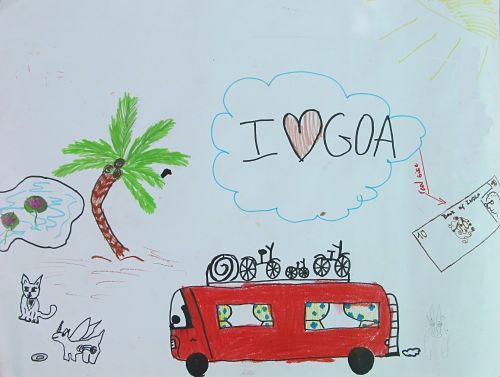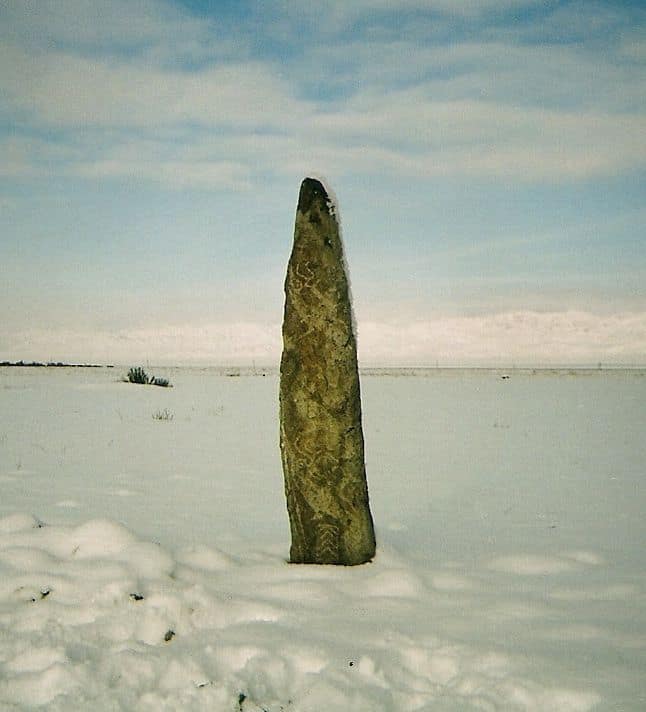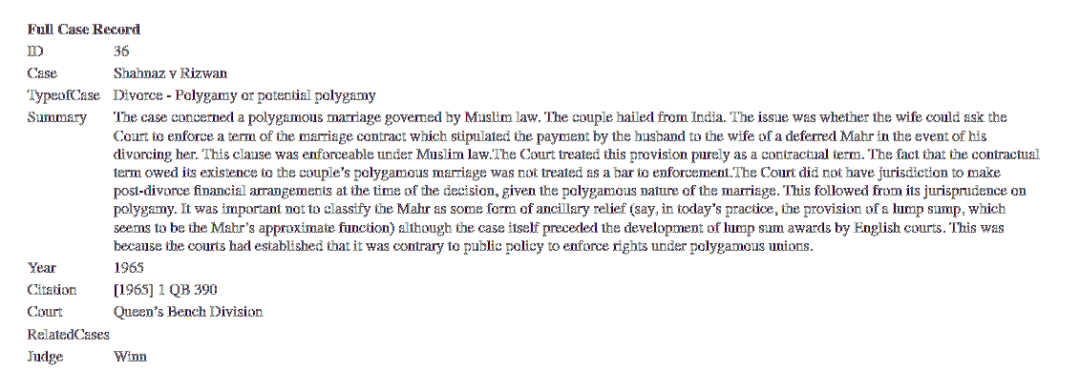Mari (the researcher), Tina (9 years), Lisa (9 years), Rose (8 years)
Mari : Think about a story of a child who is in Goa or comes to Goa, what happens to this child here?
Lisa: She came in a big red bus that was a fire engine before. They took the inside out and put sofas and beds and kitchen and everything inside and they drove with the bus from France. They started when she was two years old. All the way, they stopped in Spain and everywhere and when she was four they arrived in India and then they didn’t have any petrol and any money, so they couldn’t move the bus… that’s why they stayed here.
Tina: Can I draw a bus?
Rose: I draw all the palm trees
T: I need a big flat pen. And then I need blue… I need red… and I need yellow and orange…
M: But tell me now about the story, the bus comes to Goa and it runs out of petrol and they stay here, what happens then? How do you think this child feels? Suddenly out of petrol and out of money in Goa.
R: Well, I think she would feel a bit different.
L: Then they need to make money. Her mum starts as a yoga teacher… she studies and earns money.
M: Here is a silver color if you have coins…
L: Dollars are colorful.
M: What is on top of the bus?
L: A tent and their bicycles
T: Her mum, dad, two brothers and her.
M: So what else, this child came to Goa, the mother started to work, so they got money. Where do they live? Does the child have friends?
R: Yes because they slept in a village and there was a restaurant and there was a house and there was a girl and a boy, the neighbors and they were best friends and then she started being friends with them.
M: And what do they do together with the friends?
R: They do loads of stuff, they go to the kindergarten together.
M: Are they all the time in Goa or do they sometimes go to France or somewhere?
L: They sometimes go to France, they only have a six months’ visa.
R: I need yellow for the sun.
M: What do you like in Germany when you go there? Do you go to school in Germany?
L: I do home schooling.
M: In Germany, with your mum? Do you like that?
L: I don’t know, it’s ok; yes, it’s ok.
R: Another flower here.
T: Let’s do another flower here somewhere because it is so empty down here
L: That’s a big sun!
R: Let’s think what we put up here?
L: Some more rupees.
M: Some rupees? What they do with the money? For what do they need the money?
L: To go to school and food.
M: So here we have a lake and a palm tree; it is a coconut tree, isn’t it? Then there is the bus with the bicycles on the top.
R: Maybe we draw a cow here?
The above discussion was recorded during a drawing session where I asked a group of three girls to tell me a story about a child who arrives in Goa, India. Such drawing sessions were a part of my ethnographic fieldwork among lifestyle migrant children in Goa.
Increasing numbers of “Western” families are involved in a lifestyle where they spend several months a year in Goa and the rest of the time in the parents’ native countries and possibly also in some other places. The lifestyle choice is motivated by a search for “a better quality of life”.
My research project “Mobile Childhood. Children of Lifestyle Migrants in Goa, India.” (2011-2013) investigated how 2-12-year-old children experience this lifestyle chosen by their parents. I investigated the social and cultural environment in which the “the Goa kids” live and I asked how they experience and view the transnationally mobile way of life. I also asked how they define their identities and belonging.
I conducted ethnographic fieldwork in Goa for about ten months. My research material consists of field diaries of my participant observation, interviews with children, parents and people who work with the children (e.g. teachers) as well as drawing projects.
In groups of 3-5 children, I asked the children to draw me pictures related to my research theme (home, India, family etc.) and while they were drawing, I chatted with them about those themes.
In addition, I asked children to tell me fictional stories of children who arrive in Goa and to draw pictures to go with the stories. The example above is an example of such a drawing session. This method turned out to be an excellent way to get to know about children’s views and discourses.
A short video presentation on the research:
References:
Korpela, Mari 2014. Growing up cosmopolitan? Children of Western Lifestyle Migrants in Goa, India. COLLeGIUM. Studies across disciplines in the humanities and social sciences. Vol. 15, 90-115.
Korpela, Mari 2014. Lifestyle of Freedom? Individualism and Lifestyle Migration. In Michaela Benson & Nick Osbaldiston (eds.) Understanding Lifestyle Migration. Theoretical Approaches to Migration and the Quest for a Better Way of Life. Palgrave Mcmillan. 27-46.
Korpela, Mari 2013. Marginally Mobile? The Vulnerable Lifestyle of the Westerners in Goa. Two Homelands 38, 63-72.





Hello Mari! Thank you very much for sharing and doing this interesting research.
For my opinion the children in Goa are living a beautiful and complete life, full of joy and great experiences but they could share more the company of the local children
Hello Mari! I agree with Claudia that children living in Goa and other countries chosen by lifestyle migrants are experiencing an extraordinary life. Yet, I do share your concern about preparedness of our institutions to deal with these cosmopolitan nomads once they would like to enter a University, look for a job, enter politics etc. Is there a way our society can learn to appreciate and embrace these ‘new people’? Or would they be looked at ‘some hippie offspring’, not reliable to entrust a ‘real, serious’ job?